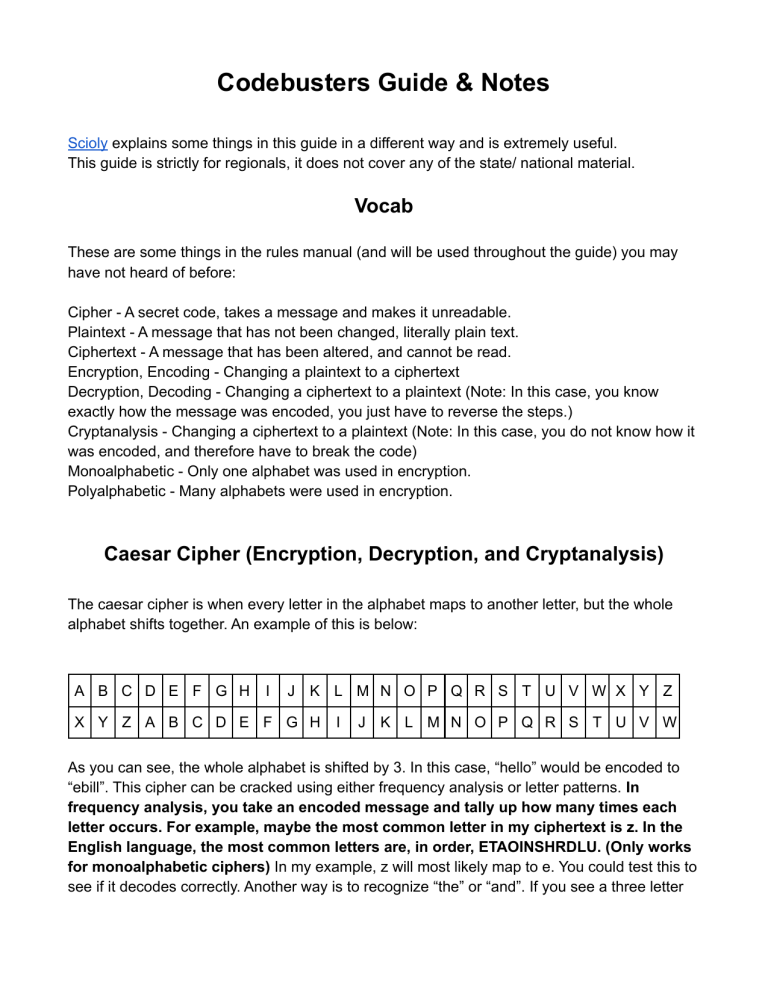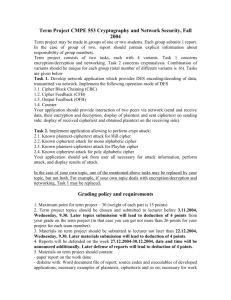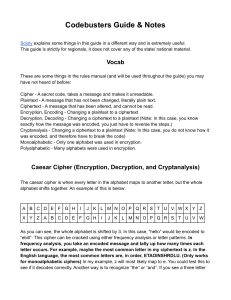
Codebusters Guide & Notes Scioly explains some things in this guide in a different way and is extremely useful. This guide is strictly for regionals, it does not cover any of the state/ national material. Vocab These are some things in the rules manual (and will be used throughout the guide) you may have not heard of before: Cipher - A secret code, takes a message and makes it unreadable. Plaintext - A message that has not been changed, literally plain text. Ciphertext - A message that has been altered, and cannot be read. Encryption, Encoding - Changing a plaintext to a ciphertext Decryption, Decoding - Changing a ciphertext to a plaintext (Note: In this case, you know exactly how the message was encoded, you just have to reverse the steps.) Cryptanalysis - Changing a ciphertext to a plaintext (Note: In this case, you do not know how it was encoded, and therefore have to break the code) Monoalphabetic - Only one alphabet was used in encryption. Polyalphabetic - Many alphabets were used in encryption. Caesar Cipher (Encryption, Decryption, and Cryptanalysis) The caesar cipher is when every letter in the alphabet maps to another letter, but the whole alphabet shifts together. An example of this is below: A B C D E F G H I J K L M N O P Q R S T U V W X Y Z X Y Z A B C D E F G H I J K L M N O P Q R S T U V W As you can see, the whole alphabet is shifted by 3. In this case, “hello” would be encoded to “ebill”. This cipher can be cracked using either frequency analysis or letter patterns. In frequency analysis, you take an encoded message and tally up how many times each letter occurs. For example, maybe the most common letter in my ciphertext is z. In the English language, the most common letters are, in order, ETAOINSHRDLU. (Only works for monoalphabetic ciphers) In my example, z will most likely map to e. You could test this to see if it decodes correctly. Another way is to recognize “the” or “and”. If you see a three letter pattern commonly recurring, for example “zyr”, it is most likely “the” or “and”, and can be used to decode the entire cipher. Monoalphabetic Substitution (Encryption, Decryption, and Cryptanalysis) In this section of the rules, you will see the words aristocrat and patristocrat. Aristocrat means the cryptogram has spaces, for example “bx sdpn acs icasnb”. Patristocrat is without spaces, for example “bxsdpnacsicasnb”. They have many variations too, but those don’t really make a difference. They are very similar to Caesar ciphers, but don’t exactly map. For example if “A” maps to “X”, “B” doesn’t necessarily have to map to “Y”, it could map to “K” for example. These have the same cryptanalysis methods as caesar cipher, but letter patterns will not work for patristocrats. Affine Cipher (Encryption and Decryption) The Affine cipher is slightly mathematical, and every letter maps to a number (a is always 0, b is 1...). The examiners will give an a and b value (not to be confused with letters), which is used for encryption and decryption. The encryption formula is ax + b mod 26, where x is the letter. Mod is a remainder operation, so 12 mod 5 = 2 and 4 mod 10 = 4. Let’s say a = 3 and b = 4. The letter c is 3, so encrypting with this formula would be 3(3) + 4 = 9 + 4 = 13. 13 is n, so c would map to n. Vigenere (Polyalphabetic Cipher) (Encryption and Decryption) Vigenere works a little differently, and uses this grid: There will be a key, so let’s use MURPHY. Let’s say our message is SCIOISAWESOME. We would repeat the key under the message like this: S C I O I S A W E S O M E M U R P H Y M U R P H Y M You would find the coordinates on the grid for each pair of letters, so (S, M) is E. Following this, our message encrypts to EWZD… Baconian Cipher (Decryption) In the Baconian cipher, a represents 0 and b represents 1 (values, not text). Every letter of the alphabet is a number, where a is 0, b is 1, c is 2… Every letter’s number is represented by As and Bs, using a 5 digit binary number. For example, a is aaaaa, b is aaaab, c is aaaba, d is aaabb… (full table on Scioly). I and J are the same code, determined by context, and U and V are the same code. Xenocrypt (Spanish) (Cryptanalysis) This is a simple monoalphabetic cipher, but is in Spanish. The most common letters in Spanish are EAOSNRILUD. The alphabet is the same, except ñ is part of it, in the order lmnñop. Pollux and Morbit Ciphers (Decryption) For these, I highly recommend Scioly, since they explain it better than I ever could. Atbash Cipher (Encryption, Decryption, and Cryptanalysis) A simple monoalphabetic cipher with this map: A B C D E F G H I J K L M N O P Q R S T U V W X Y Z Z Y X W V U T S R Q P O N M L K J Thanks for Reading! I H G F E D C B A






